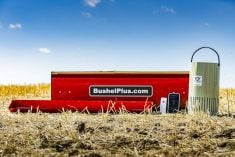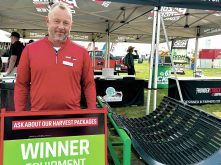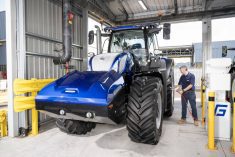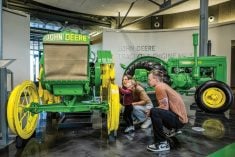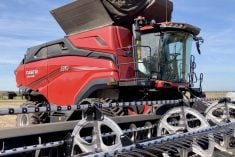In February, Case IH pulled the wraps off its Class 10-plus AF11 twin-rotor combine at the National Farm Machinery Show in Louisville, Kentucky, describing 2024 as the year of the combine. By mid-April the red brand had three more new models to debut, the 260 Series.
“You can kind of see we’re calling it the year of the combine for a reason,” says Leo Bose, harvesting segment leader at Case IH.
The current 7250, 8250 and 9250 will be replaced by the updated 7260, 8260 and 9260. A big part of that refresh has to do with digital technology. Every machine leaving the Grand Island, Nebraska, assembly plant will have a full suite of digital features built into the base models.
Read Also

Claas brings 1000 Series SP forage harvesters to Canada
In mid-August, Claas unveiled its new line of Jaguar forage harvesters at an event in Visalia, California, deep in the heart of that state’s dairy region.
“When you look at the 260 Series we’ve amped it up with the tech-infused efficiency,” says Bose. “We’re taking technology and integrating that into the base of the unit. Producers in Western Canada look at everything from guidance to machine data, whether it be machine data, and what I call Machine Sync, so you’re syncing data between each unit. Now we’ve put that into the base of the unit, so there’s no fee for those individual items.
“It’s connected for the life of the hardware. That’s the beauty of this. Rather than every 12 or 18 months having to come back (and renew a subscription), we’ve taken that away. There used to have to be an activation for each one of those. Now they’re all bundled. So leaving from the factory we can confirm they work, and the customer is ready to go to the field.”
To give operators access to all the data they want inside the cab, the combines will get dual PRO 1200 display monitors.
“In my career everyone wanted to get to one display, now we’re kind of inching back,” says Bose. “That’s one of the things we heard from our customers. We’re finding out they like the Pro 1200 display on the right-hand console and they like the second one up in the upper right-hand A post.”

The Pro 1200 also offers a camera view of the cleaned grain elevator, so operators can verify the automated Harvest Command feature, which automatically adjusts combine settings to match field conditions, has the combine working at peak efficiency. Manual changes can be made to override the automated settings if an operator prefers.
“You can see where the roadmap is going for setting and adjusting the machine and validating it through camera technology with what you are actually seeing,” says Bose. “You can make changes if you don’t agree with what Harvest Command is doing, but most customers are letting Harvest Command run and make changes automatically.”
The 260 Series machines get improved guidance steering performance with a redesigned steering system that is able to respond much faster to GPS input. That makes it more accurate during higher field speeds when working through lighter crop conditions.
The 260s will continue to use a CVT transmission, which was first introduced on the 10 Series models back in 2003. That transmission allows for fewer drive belts and can clear slugs by reversing the rotor.
“If you do plug it, you don’t have to get out of the cab,” says Bose. “Just open up the concave and rock the rotor back and forth. It really elevates the productivity and production.”
Buyers can ride on a choice of three systems, tires, the Fargo-built rigid track modules or an all-new suspended track system that offers an improved, smoother ride. It also provides a bigger footprint and improved floatation.
“If you think about a combine on tracks, it’s suspended to try and get the best experience for the operator,” says Bose. “But it’s a challenge designing a track system for a combine. If you think about a 9260, it has a 410-bushel grain tank capacity. So how do you get the track system to take the different weights? The suspension needs to change based on the weight. We call it an active and dynamic track system.
“It’s actively adjusting as we go through the field and it’s sensing the weight being placed on the tracks. We’re trying to make sure whether it’s a full or empty grain tank we’re maintaining that full ride.”
The 260 models have been in field trials with selected producers and custom harvesters for a couple of years, says Bose. The feedback has been that the new combines make things simpler for the operator, which was one of Case IH’s primary goals.
The new combines should begin arriving on dealers’ lots in late 2024.




